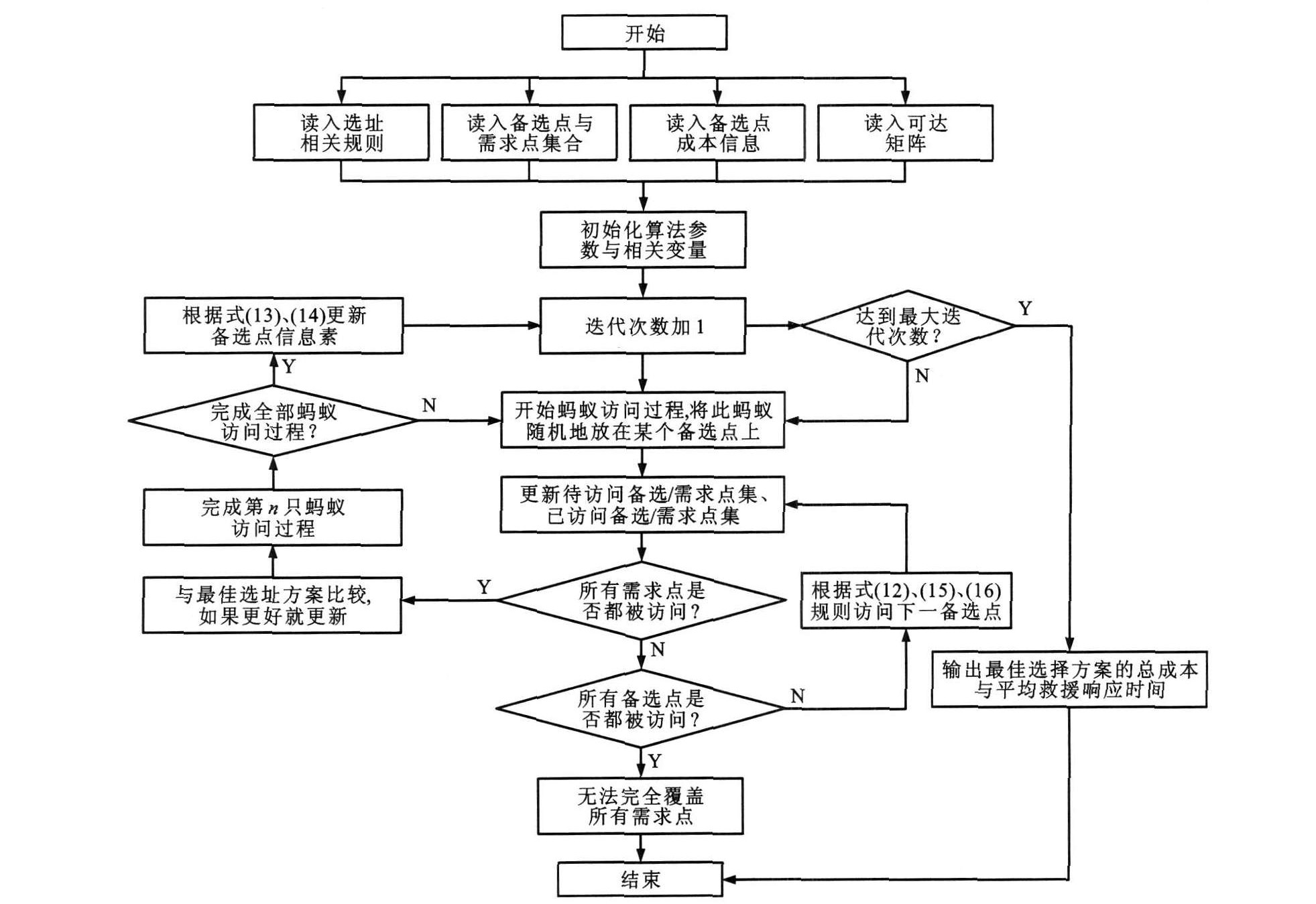Hierarchical planning location model of railway rescue center
-
摘要: 基于中国铁路组织机构的特点和应急救援现状, 提出了铁路救援基地的层级网络建设理念。分析了现有铁路救援基地多目标规划选址模型的不足, 将铁路救援基地分为枢纽救援基地和快速救援基地。以最小救援基地总成本和最短救援响应时间为双目标函数, 以最大服务距离为约束条件, 建立了铁路救援基地多目标层级规划选址模型。采用层次分析法、灰色关联分析与线性参考技术等方法抽象模型参数, 采用蚁群算法求解模型, 并将计算结果与现有的救援决策方案进行对比。研究结果表明: 应用提出的模型, 通过抽象模型参数, 可得到26个救援基地备选点、61个服务需求点与188条路径; 在完全覆盖事故风险的情况下, 救援基地数量减少3个, 节约成本约240万元, 总救援响应时间、最大平均救援响应时间和最小平均救援响应时间分别降低0.04、0.46、0.29 h。Abstract: Based on the characteristic of organization institution and the existing situation of emergency rescue for Chinese railway, the construction concept of hierarchy network for railway rescue center was proposed. The deficiency of existing multi-objective planning location model for railway rescue center was analyzed, and railway rescue center was divided into hub rescue center and fast rescue center. The minimum total cost of rescue center and the shortest rescue response time were taken as double objective functions, the maximum service distance was taken as constraint condition, and the multi-objective hierarchical planning location model was put out.Several methods such as analytic hierarchy process(AHP), gray relational analysis and linear reference technology were used to Abstract model parameters, the proposed model was solved by using ant colony optimization(ACO), and the existing rescue decision scheme and the calculation result of proposed model were compared. Research result shows that by using the proposed model, there are 26 preparation points of rescue center, 61 service demand points and 188 paths through parameter Abstraction.When accident risk is completely covered, the number of rescue centers decreases by 3, the cost decreases by 2 400 000 yuan, and the total rescue response time, the maximum average rescue response time and the minimum average rescue response time decrease by 0.04, 0.46, 0.29 h respectively.
-
表 1 救援列车参数
Table 1. Parameters of rescue trains
类型 参数 运行速度/(km·h-1) 起重能力/t 救援半径/km 60 t固定臂 ≤80 60 150 100 t固定臂 80 100 200 160 t固定臂 85 160 200 160 t伸缩臂 120 160 200 表 2 影响因素权重
Table 2. Weights of influence factors
项目 A1 A2 A3 A4 权重 0.56 0.26 0.12 0.06 重要程度值 4 3 2 1 表 3 影响因素等级划分
Table 3. Grade division of influence factors
序号 项目 子项目与等级 Ⅰ Ⅱ Ⅲ 1 机务设备分布/km ≥30 20~30 ≤20 子项目评分 4 8 12 2 线路密度/条 1 2 ≥3 子项目评分 3 6 9 3 辅助运输方式/km ≥25 1~25 ≤1 子项目评分 2 4 6 4 公共机构分布/km ≥30 20~30 ≤20 子项目评分 1 2 3 表 4 决策方案比较
Table 4. Comparison of decision schemes
方案 参数 建设救援基地数量/个 建设管理维护成本/万元 需求点风险覆盖率/% 总救援响应时间/h 最大平均救援响应时间/h 最小平均救援响应时间/h 当前方案 14 1 180 100 1.53 2.41 0.93 本文方案 11 940 100 1.49 1.95 0.64 -
[1] 张殿业, 金键, 杨京帅. 铁路运输安全理论与技术体系[J]. 中国铁道科学, 2005, 26(3): 114-118. doi: 10.3321/j.issn:1001-4632.2005.03.024ZHANG Dian-ye, JIN Jian, YANG Jing-shuai. Theoretic and technical research framework of railway transportation safety[J]. China Railway Science, 2005, 26(3): 114-118. (in Chinese). doi: 10.3321/j.issn:1001-4632.2005.03.024 [2] 张殿业, 金键, 郭孜政, 等. 铁路行车事故救援理论与技术体系探讨[J]. 铁道学报, 2006, 28(5): 11-15. doi: 10.3321/j.issn:1001-8360.2006.05.003ZHANG Dian-ye, JIN Jian, GUO Zi-zheng, et al. Exploration of the theoretic and technical systems of train operation accident emergency and rescue[J]. Journal of the China Railway Society, 2006, 28(5): 11-15. (in Chinese). doi: 10.3321/j.issn:1001-8360.2006.05.003 [3] 张杰, 苗金明, 周心权, 等. 安全生产效益的分析评价及其与安全投入的关系[J]. 中国安全科学学报, 2009, 19(3): 50-54. https://www.cnki.com.cn/Article/CJFDTOTAL-ZAQK200903011.htmZHANG Jie, MIAO Jin-ming, ZHOU Xin-quan, et al. Analysis and evaluation on the effect of work safety and its relation with safety investment[J]. China Safety Science Journal, 2009, 19(3): 50-54. (in Chinese). https://www.cnki.com.cn/Article/CJFDTOTAL-ZAQK200903011.htm [4] 吴艳华. 铁路救援基地选址模型与应用研究[D]. 北京: 中国铁道科学研究院, 2011.WU Yan-hua. Research on model and application of railway rescue center location[D]. Beijing: China Academy of Railway Sciences, 2011. (in Chinese). [5] 刘仍奎, 程晓卿, 孙全欣. 铁路事故救援系统的构建研究[J]. 中国安全科学学报, 2004, 14(11): 43-47. doi: 10.3969/j.issn.1003-3033.2004.11.009LIU Reng-kui, CHENG Xiao-qing, SUN Quan-xin. Study on construction of emergency rescue system for railway[J]. China Safety Science Journal, 2004, 14(11): 43-47. (in Chinese). doi: 10.3969/j.issn.1003-3033.2004.11.009 [6] HAKIMI S L. Optimum distribution of switching centers in a communication network and some related graph theoretic problems[J]. Operations Research, 1964, 13(3): 462-475. [7] TOREGAS C, SWAIN R, REVELLE C, et al. The location of emergency services facilities[J]. Operations Research, 1971, 19(6): 1363-1373. doi: 10.1287/opre.19.6.1363 [8] VERTER V, LAPIERRE S D. Location of preventive health care facilities[J]. Annals of Operations Research, 2002, 110(1/2/3/4): 123-132. [9] BERMAN O, VERTER V, KARA B Y. Designing emergency response networks for hazardous materials transportation[J]. Computers and Operations Research, 2007, 34(5): 1374-1388. doi: 10.1016/j.cor.2005.06.006 [10] 牛宏睿. 铁路应急资源优化调度问题的研究及系统实现[D]. 北京: 中国铁道科学研究院, 2009.NIU Hong-rui. Study and system implementation on railway emergencyresource optimization and dispatch[D]. Beijing: China Academy of Railway Sciences, 2009. (in Chinese). [11] 周慧娟, 贾利民. 基于区间数的铁路应急服务设施点选址优化[J]. 物流技术, 2010, 29(12): 129-132. https://www.cnki.com.cn/Article/CJFDTOTAL-WLJS2010Z2042.htmZHOU Hui-juan, JIA Li-min. Interval-based location optimization of railway emergency service facilities[J]. Logistics Technology, 2010, 29(12): 129-132. (in Chinese). https://www.cnki.com.cn/Article/CJFDTOTAL-WLJS2010Z2042.htm [12] 龙京, 黄钢, 王孟钧, 等. 铁路应急物资储备点选址[J]. 交通运输工程学报, 2011, 11(1): 74-78. http://transport.chd.edu.cn/article/id/201101013LONG Jing, HUANG Gang, WANG Meng-jun, et al. Reserve depot location of railway emergency material[J]. Journal of Traffic and Transportation Engineering, 2011, 11(1): 74-78. (in Chinese). http://transport.chd.edu.cn/article/id/201101013 [13] 李小平, 唐士晟. 铁路救援指挥系统中IDSS的构建方法研究[J]. 铁道学报, 2008, 30(5): 20-24. https://www.cnki.com.cn/Article/CJFDTOTAL-TDXB200805004.htmLI Xiao-ping, TANG Shi-sheng. Research of construction method of IDSS in the railway rescue command system[J]. Journal of the China Railway Society, 2008, 30(5): 20-24. (in Chinese). https://www.cnki.com.cn/Article/CJFDTOTAL-TDXB200805004.htm [14] 陈昭明, 王林泽, 马林. 铁路事故救援辅助决策系统的研究[J]. 铁道学报, 2004, 26(5): 8-13. https://www.cnki.com.cn/Article/CJFDTOTAL-TDXB200405002.htmCHEN Zhao-ming, WANG Lin-ze, MA Lin. Study on railway rescue decision aiding system[J]. Journal of the China Railway Society, 2004, 26(5): 8-13. (in Chinese). https://www.cnki.com.cn/Article/CJFDTOTAL-TDXB200405002.htm [15] 穆瑞, 张家泰. 基于灰色关联分析的层次综合评价[J]. 系统工程理论与实践, 2008, 28(10): 125-130. https://www.cnki.com.cn/Article/CJFDTOTAL-XTLL200810019.htmMU Rui, ZHANG Jia-tai. Research of hierarchy synthetic evaluation based on grey relational analysis[J]. Systems Engineering—Theory and Practice, 2008, 28(10): 125-130. (in Chinese). https://www.cnki.com.cn/Article/CJFDTOTAL-XTLL200810019.htm [16] 柳林, 陈钠. 基于灰色关联分析的城市轨道交通项目可持续发展评价[J]. 铁道运输与经济, 2008, 30(6): 46-49. https://www.cnki.com.cn/Article/CJFDTOTAL-TDYS200806018.htmLIU Lin, CHEN Na. Evaluation on sustainable development of urban rail transit project based on grey relational analysis[J]. Railway Transport and Economy, 2008, 30(6): 46-49. (in Chinese). https://www.cnki.com.cn/Article/CJFDTOTAL-TDYS200806018.htm [17] 孙勇成, 周献中, 李桂芳, 等. 基于灰色关联分析的仿真模型验证及其改进[J]. 系统仿真学报, 2005, 17(3): 522-524. https://www.cnki.com.cn/Article/CJFDTOTAL-XTFZ200503003.htmSUN Yong-cheng, ZHOU Xian-zhong, LI Gui-fang, et al. Validation of simulation models based on grey relational analysis and improvement[J]. Journal of System Simulation, 2005, 17(3): 522-524. (in Chinese). https://www.cnki.com.cn/Article/CJFDTOTAL-XTFZ200503003.htm [18] 段海滨, 王道波, 于秀芬. 蚁群算法的研究现状及其展望[J]. 中国工程科学, 2007, 9(2): 98-102. https://www.cnki.com.cn/Article/CJFDTOTAL-GCKX200702016.htmDUAN Hai-bin, WANG Dao-bo, YU Xiu-fen. Ant colony algorithm: survey and prospect[J]. Engineering Science, 2007, 9(2): 98-102. (in Chinese). https://www.cnki.com.cn/Article/CJFDTOTAL-GCKX200702016.htm [19] 张勇德, 黄莎白. 多目标优化问题的蚁群算法研究[J]. 控制与决策, 2005, 20(2): 170-173. https://www.cnki.com.cn/Article/CJFDTOTAL-KZYC200502011.htmZHANG Yong-de, HUANG Sha-bai. On ant coloy algorithm for solving multiobjective optimization problems[J]. Control and Decision, 2005, 20(2): 170-173. (in Chinese). https://www.cnki.com.cn/Article/CJFDTOTAL-KZYC200502011.htm [20] 陈立伟, 唐权华. 基于蚁群算法的离散救援问题出救点选址研究[J]. 计算机应用研究, 2010, 27(11): 4152-4154. https://www.cnki.com.cn/Article/CJFDTOTAL-JSYJ201011041.htmCHEN Li-wei, TANG Quan-hua. Research on depot location of discrete emergency aid based on ACO[J]. Application Research of Computers, 2010, 27(11): 4152-4154. (in Chinese). https://www.cnki.com.cn/Article/CJFDTOTAL-JSYJ201011041.htm -





 下载:
下载:




